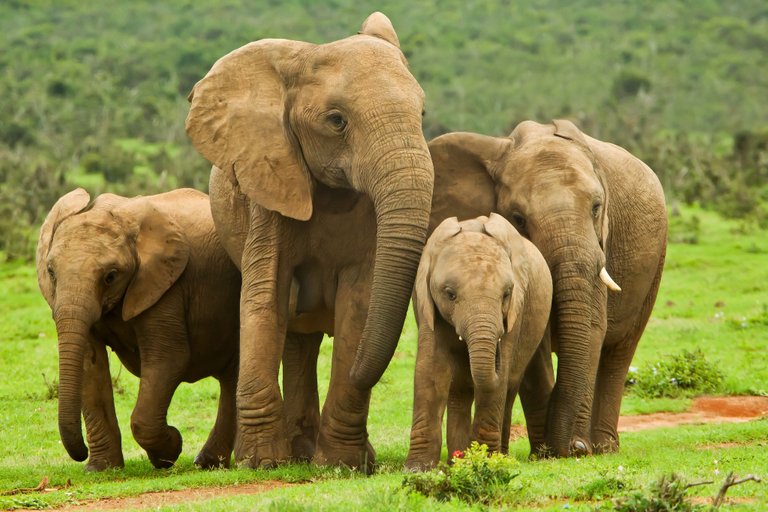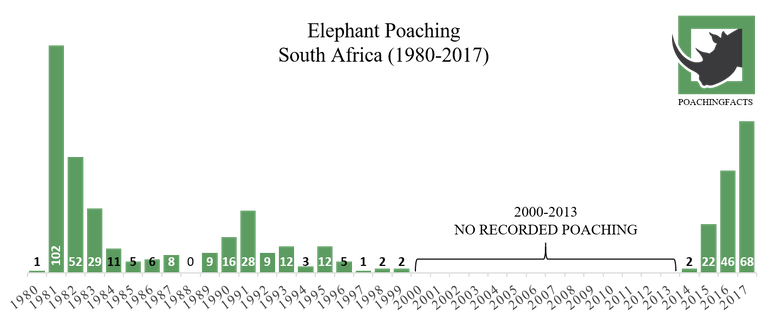The average size of elephant tusks is rapidly shrinking among most elephant populations.

Image source
Surviving the slaughter
Elephant populations are under enormous pressure from poachers. Although the populations of Asian elephants are also reducing, this is rarely due to poaching. African elephants simply have bigger tusks than Asian elephants, and tusks are made of ivory which sells for a fortune, mainly on the black market.
And that's the clue, of course. Poachers look for elephants with large tusks because they make much more money for the same work as killing one with small tusks—and none for no tusks at all.
Rapid change
Rapid evolution tends to occur when a population is placed under severe stress for survival. Local, rapid evolution is seen everywhere in our cities. The more pressure put on a local population the more likely the survivors will adapt to be more resilient.

Super-strong bedbug. Image source
Take, for example, bedbugs. New York City has for a very long time had a big problem with bedbugs. Fifty years ago they were almost eradicated using DDT. But they're back again in numbers thanks to having evolved thicker shells and nerve cells that are super-resistant to the pesticides thrown at them. To appreciate how local this is, New York City bedbugs are now 250 times more resistant to pesticides than the bedbugs in Florida.
The mechanics of change
So what's the mechanism? How does an animal that has taken about 80 million years to evolve into the modern elephant after splitting from primates? The “newest” elephant species is the African elephant, Loxodonta, and it appeared about 1.5 million years ago. That's a long, long time. So how can a key feature of the species change in mere decades?
Female African elephants also have tusks, unlike their Asian elephant cousins. Their tusks are significantly smaller than the males, yet they are still hunted for their ivory, particularly as male elephant numbers have dropped dramatically. Under normal circumstances, only about two to four percent of females are tuskless, a genetic quirk.

Image source
New research has shown that 51 percent of the adult females—25 years or older—who survived the war in Mozambique are tuskless. 32 percent of the female elephants born since then are tuskless.
As the larger-tusked males were wiped out, so the overall percentage of males with smaller tusks grew, simply because they were less attractive targets for the poachers. Adding to the heritable effect of females having smaller (or no) tusks, the fact that the large tuskers had largely been wiped out gave the genes of the other males a chance to be passed on to the next generation of elephants.
Only bull elephants who dominate the herd and have seen off challenges from competing bulls will mate with the females. Bulls with larger tusks have a much better chance of defeating bulls with smaller tusks in a fight. So there is a built-in bias toward larger tusk-producing genes dominating the localised gene-pool—a kind of positive feedback causing a rapid change in the average tusk size.
Does that mean that elephants will forever have smaller tusks? No—there will always be a percentage of the elephant population carrying the larger tusk gene, and if the evolutionary pressure was removed, i.e.: poaching is stopped, the larger tusk-producing bias would probably restore the old balance fairly rapidly.
So, in a way, evolution has come to the rescue of some elephants. But although this evolutionary change was extremely rapid, it's no swat team; the onslaught on elephants has been too great. Without rapid intervention from humans to stop the slaughter, evolutionary changes might have come too late for these majestic, intelligent animals.

References:
National Geographic: Under poaching pressure, elephants are evolving to lose their tusks
New York Times: Where Female Elephants Without Tusks Roam — and Poachers Stay Away
Poaching Facts: Elephant Poaching Statistics
Understaning Evolution: Bed bugs bite back thanks to evolution
EleAid: Elephant Evolution
Also posted on Weku, @tim-beck, 2019-01-16
Perhaps the elephants with evolution will carry on long after man has departed. Will take some getting used to seeing an elephant with smaller/no tusks, but if that is what it takes to survive, get used to it!
Thanks for interesting article @tim-beck #teamsouthafrica
I think one thing that has become clear to me is that that greater the diversity within a species the greater it's chance of survival. We too will survive for a long time because we have great diversity as a species. But in what form?
Contrary to your belief I think humans will annihilate themselves through over breeding, greed, not being able to live together.
If mankind wish to make a long lasting footprint anywhere they need to work together with a common purpose. Deviate from petty strife, sadly humans have not developed nor adapted even with our assumed intelligence.
Congratulations @tim-beck! You have completed the following achievement on the Steem blockchain and have been rewarded with new badge(s) :
Click here to view your Board
If you no longer want to receive notifications, reply to this comment with the word
STOPTo support your work, I also upvoted your post!
I saw this first-hand in East Africa in the Masai Mara... the elephants, especially those outside the official reserve had no tusks.